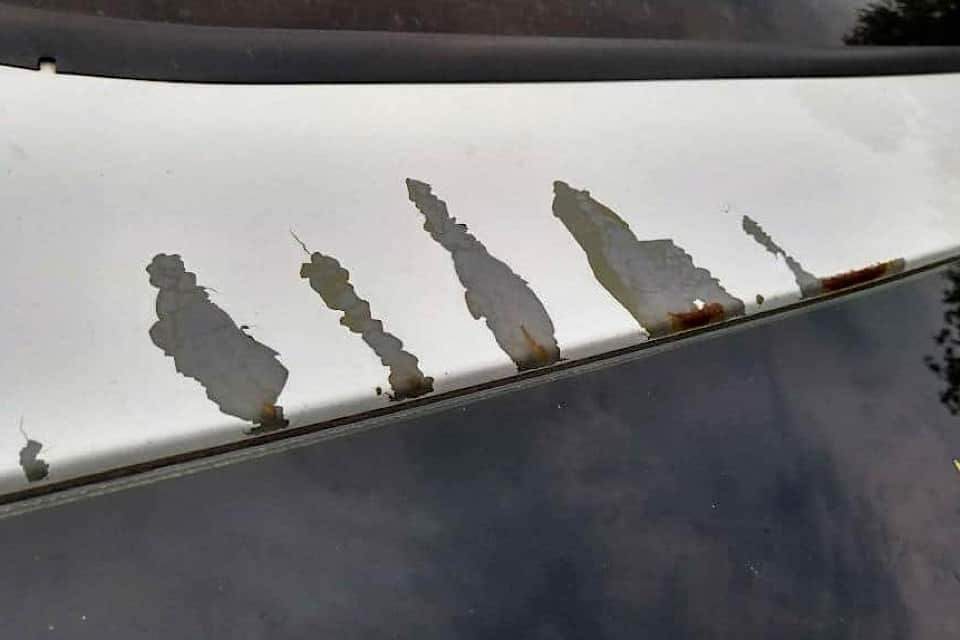Hyundai's Self-Healing Paint is Really Good at Self-Peeling
- Hyundai's self-healing paint is marketed as a more durable paint option that can remove minor scratches.
- Defects in the paint cause it to peel off in giant sheets.
- A class-action lawsuit looking to get some help from Hyundai fell apart in 2017.

Hyundai's self-healing paint is more self-destructive than anything. Rather than healing minor scratches as advertised, it tends to peel off in giant sheets.
Although I guess technically the scratch is gone once the paint comes off.
The Self-Healing Paint Lawsuit ∞
In the case, Michelle Resnick, et al. vs. Hyundai Motor America Inc., the plaintiffs argued that Hyundai's paint fails to meet industry standards.
The plaintiffs say the self-healing process won't work if the scratch is deeper than a surface scratch, such as a chip in the paint caused by a rock flying off the road and hitting the car. Further, there is a concern that if the self-healing process does not occur, the scratch or chip may cause further breakdown of the paint’s molecular structure, in essence triggering the technology to operate in reverse.
The case eventually fell apart. The judge dismissed it after the plaintiffs failed to amend their complaints.
As for the paint being just an issue of aesthetics, the plaintiffs claim this is false because the paint is there not only for looks but to protect the body of the vehicles from corrosion and rust damage. However, the judge didn't buy it.
Meanwhile, the paint continues to fall apart too.
Generations Where This Problem Has Been Reported
This problem has popped up in the following Hyundai generations.
Most years within a generation share the same parts and manufacturing process. You can also expect them to share the same problems. So while it may not be a problem in every year yet, it's worth looking out for.
3rd Generation Elantra
- Years
- 2001–2006
- Reliability
- 36th out of 50
- PainRank™
- 6.9
- Complaints
- 108
4th Generation Elantra
- Years
- 2007–2010
- Reliability
- 43rd out of 50
- PainRank™
- 15.63
- Complaints
- 181
5th Generation Elantra
- Years
- 2011–2016
- Reliability
- 49th out of 50
- PainRank™
- 45.43
- Complaints
- 937
3rd Generation Santa Fe
- Years
- 2013–2018
- Reliability
- 46th out of 50
- PainRank™
- 19.69
- Complaints
- 270
5th Generation Sonata
- Years
- 2006–2010
- Reliability
- 47th out of 50
- PainRank™
- 19.96
- Complaints
- 384
6th Generation Sonata
- Years
- 2011–2014
- Reliability
- 50th out of 50
- PainRank™
- 68.11
- Complaints
- 1312
Further Reading
A timeline of stories related to this problem. We try to boil these stories down to the most important bits so you can quickly see where things stand. Interested in getting these stories in an email? Signup for free email alerts for your vehicle over at CarComplaints.com.
A peeling paint lawsuit has fallen apart after a judge’s recent dismissal.
The judge said this dismissal is with prejudice because the plaintiffs keep repeating the same allegations that were already dismissed.
In other words, the plaintiffs had their chance and blew it. The original lawsuit alleged that Hyundai’s paint falls apart as the polymers break down and make the paint susceptible to peeling and flaking.
keep reading article "Judge Puts Nail in then Coffin of the Hyundai Peeling Paint Lawsuit"A pe
ling paint lawsuit has been dismissed by a California district judge.
Whether Hyundai knew the paint was defective was a question because the automaker said third-party websites talked about the problems, but customers weren't complaining directly to Hyundai. In other words, if customers don't complain directly to Hyundai, no one can prove the automaker had prior knowledge of alleged problems.
This is a terrible argument. Third party websites, like CarComplaints.com, are not only useful for venting. Complaint data is collected, compiled, and shared to other owners who might be having the same problem. Seeing how many others are facing a similar issue can be a catalyst for action.…
keep reading article "Peeling Paint Lawsuit Dismissed"A class-action lawsuit accuses Hyundai of failing to meet industry standards with their paint in the 2006-2016 Santa Fe, Sonata, and Elantra.
The plaintiffs say the self-healing process won't work if the scratch is deeper than a surface scratch, such as a chip in the paint caused by a rock flying off the road and hitting the car. Further, there is a concern that if the self-healing process does not occur, the scratch or chip may cause further breakdown of the paint’s molecular structure, in essence triggering the technology to operate in reverse.
Hyundai’s “self-healing” paint is advertised to heal minor scratches. A chemical compound called scratch recovery clear contains a polymer which, when exposed to ultraviolet light, becomes molten and fills gaps in paint.
That sounds great, but the plaintiffs claim that long-term exposure to ultraviolet light eventually breaks the polymers down, turning the paint into an ever-molten state that allows it to peel off in sheets.
keep reading article "Lawsuit Says Self-Healing Paint Does More Harm Than Good"